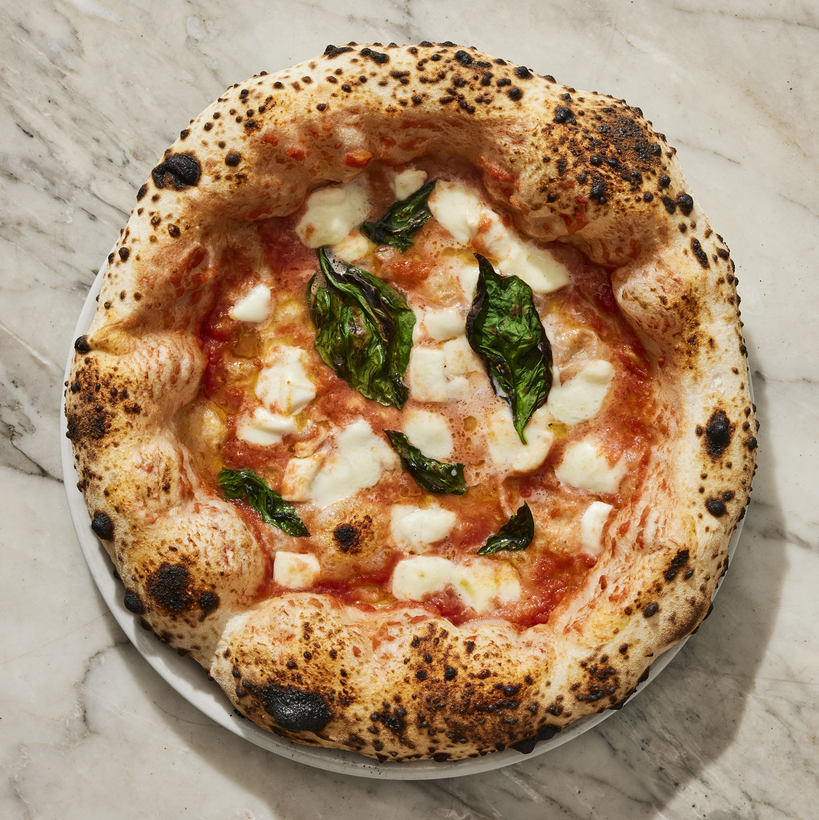Any conversation with Antonio Pace, the president of the nonprofit organization Associazione Verace Pizza Napoletana (A.V.P.N.), is likely to begin with his favorite anecdote: “When staying with an English lord, a Texan oil magnate admired the castle’s lush lawn and asked, ‘How did you achieve such perfect grass?’ The English lord replied, ‘It’s been sown, cut, and meticulously tended for 400 years.’”
This, Pace tells me over the phone, is what he aims to do with Neapolitan pizza. “He’s essentially the head of the pizza police,” a friend from Naples tells me.
The mission of the AVPN is to preserve the city’s culinary heritage by certifying pizzaioli (pizza-makers), pizzerias, and ingredients around the world based on strict guidelines, which are compiled in a 22-page document on its Web site. If a restaurant or pizzaiolo veers from the traditional method outlined by this criteria, their certification is revoked.

As of today, A.V.P.N.’s headquarters, outside the Reggia di Capodimonte, has nine employees. A pizzaiolo, Pace, 78, wears a suit to work every day. Tables for cooking classes, which are held twice daily, line the ground floor. Upstairs, Pace’s office is filled with commemorative plaques for his service to the city. Adjacent offices are occupied by other men with important-sounding titles—Massimo di Porzio, vice president; Paolo Surace, general secretary; and Gianluca Liccardo, marketing manager.
Together, this little team of nine works hard to preserve the sanctity of Neapolitan pizza around the world. “We fight every day,” Pace, whose last name means “peace” in Italian, says.
“He’s essentially the head of the pizza police.”
The fight has paid off. Over recent years, Pace and his team have certified 1,049 pizzerias, from Ribalta in New York to La Piccola Tavola in Tokyo. As of November, they’d opened a pizza-making school at the University of Kyoto, which joins 15 other A.V.P.N. schools in countries including Poland, Turkey, and Brazil—as well as in Marina del Rey, California. At the East Coast location, in Englewood, New Jersey, a five-day course, which comprises theoretical classes and practical instruction, goes for $2,950.

The Englewood school doubles as an office, where an affiliate team keeps tabs on the 69 A.V.P.N.-certified pizzerias in the U.S., including Settebello, in Los Angeles, and Song’E Napule, in New York.
“It might seem complicated, but it’s simple,” Pace tells me. “We protect and preserve.”
Meeting of the Pizza Minds
The A.V.P.N. dates back to 1984, when consumer culture in Italy was on the rise. It was the age of Pop art, high fashion, and fast food—frozen pizzas were starting to line the shelves of supermarkets, and chains like Domino’s were taking the country by storm.
Antonio Pace had grown up in a family that revered pizza—his father, Vincenzo, had been a pizzaiolo in Naples since the age of 10—and looked upon these developments with horror. So he enlisted the city’s top pizzaioli, including Antonio Aversano, of Don Salvatore, and Lello Surace, of Mattozzi, to help him narrow down the key premises for true Neapolitan pizza. As the A.V.P.N. Web site states, all had “the pizza ideal in their blood.”
The first meeting among the pizzaioli was heated. The group finally agreed on a set of guidelines for the two basic types of Neapolitan pizza, marinara (tomato sauce) and margherita (tomato sauce and mozzarella), on June 14, 1984. “We are against the cultural and commercial deformation of our pizza,” they told the Italian newspaper Il Corriere della Sera at the time, “and against its industrialization.”

The guidelines haven’t changed much since then. According to the A.V.P.N., pies should not be larger than 14 inches in diameter, with a 0.4-to-0.8-inch crust. The dough—a combination of “flour, yeast, water, salt, and, of course, a lot of passion,” Pace says—should be “soft, elastic, and easy to fold.” The sauce should be made from San Marzano tomatoes, and all of the ingredients should come from a list of A.V.PN.-verified suppliers (like the flour brand Denti, the tomato-sauce brand Cirio, and the oven brand Acunto). Fior di latte and mozzarella di bufala should be evenly distributed on the dough and topped with a few fresh basil leaves. No pepperoni, pineapple, or other blasphemous toppings of any kind are permitted.
“We are against the cultural and commercial deformation of our pizza and … its industrialization.”
By 1989, the A.V.P.N. had grown to be so popular that crowds flocked to Naples’s Excelsior hotel for a party hosted by the foundation in honor of the margherita pizza’s centenary. (While the first official pizza dates back to 1830, the first margherita was presented to Queen Margherita of Savoy by the Neapolitan chef Raffaele Esposito in 1889.) Later that year, the group took over the Galleria Umberto I for a worldwide pizza conference. “We started getting press from everywhere,” Pace says. “I wasn’t really surprised by The New York Times. I was more shocked by the Bangkok Post.”

In 1995, Pace’s fight with the Northern Italian pizzaiolo Romano Fornasari over his recipe for margherita pizza made U.S. headlines. “He would do well to occupy his time with Grana Padano instead,” Pace said at the time. “He should leave pizza alone.” (Needless to say, Fornasari’s A.V.P.N. certification was duly revoked.)
In 1997, the A.V.P.N. filed a pizza patent with the Italian Chamber of Commerce—a step toward achieving a D.O.C. (Denominazione di Origine Controllata) designation, an official recognition for Italian products adhering to traditional standards. International expansion came next, with the certification of the group’s first U.S. restaurant, Peppe Mieli’s Antica Pizzeria, in Los Angeles.
The dough—a combination of “flour, yeast, water, salt, and, of course, a lot of passion”—should be “soft, elastic, and easy to fold.” No pepperoni, pineapple, or other blasphemous toppings of any kind are permitted.
Today, in an effort to keep expanding its network, the A.V.P.N. has enlisted inspectors from its “pizza’s fan club,” a group of volunteers who monitor quality and ensure that A.V.P.N. protocols are respected throughout all of the certified locations. “We have eyes everywhere,” Pace says. “We have created an army of inspectors who are the true friends of Neapolitan pizza.”

If a pizzeria falls short of A.V.P.N. parameters, it’s given a 30-day grace period, after which an inspector arrives and sends notes back to A.V.P.N. headquarters. Then the ultimate decision is Pace’s—“I can tell immediately from a photo or two if a pizza is a true Neapolitan pizza,” he says.
As trivial as this might all sound, Pace’s serious approach appears to be working. A.V.P.N.’s Instagram account has nearly 50,000 followers, and holds a yearly, worldwide contest for the best pizza, which is judged by an international panel of pizzaioli.
The other night, I tried to have dinner at Una Pizza Napoletana, on downtown Manhattan’s Orchard Street, which is widely considered to be New York’s best Neapolitan pizzeria. It opens at five P.M. on Thursdays, Fridays, and Saturdays, and closes when the dough runs out. By 4:45, a long line had already snaked around the block.
The crowd seemed to all want the same thing: a doughy pie with a thick, non-charred crust, a satisfying lake of San Marzano tomato sauce in the middle, fior di latte cheese on top, and a sprinkling of basil, but not too much.
Elena Clavarino is a Senior Editor at AIR MAIL


